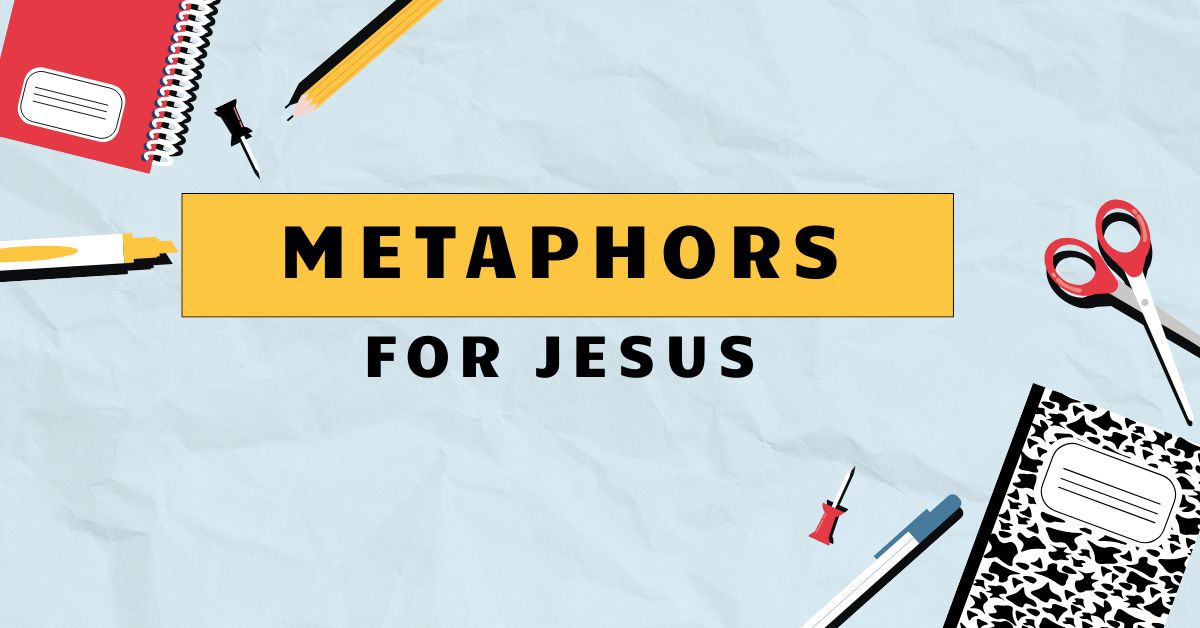35 Metaphors for Jesus: Understanding Symbolic Language
Understanding the metaphors used to describe Jesus is crucial for interpreting religious texts and grasping theological concepts. Metaphors provide a powerful way to convey complex ideas by relating them to familiar concepts and experiences.
This article explores the various metaphors used for Jesus, their meanings, and their significance in religious discourse. It benefits students of theology, literature, and anyone interested in understanding the symbolic language used in religious contexts.
Mastering this topic enhances comprehension of religious texts and deepens one’s appreciation for the richness of metaphorical language. This guide will cover definitions, structural breakdowns, examples, and usage rules to clarify the topic.
Table of Contents
- Definition of Metaphor for Jesus
- Structural Breakdown of Metaphors
- Types and Categories of Metaphors for Jesus
- Examples of Metaphors for Jesus
- Usage Rules for Metaphors
- Common Mistakes in Interpreting Metaphors
- Practice Exercises
- Advanced Topics in Metaphorical Theology
- Frequently Asked Questions
- Conclusion
Definition of Metaphor for Jesus
Ametaphoris a figure of speech in which a word or phrase is applied to an object or action to which it is not literally applicable. It’s a way of describing something by comparing it to something else, suggesting a resemblance or analogy.
In the context of religious texts, metaphors for Jesus are used to convey his character, role, and significance in a symbolic and evocative way. These metaphors often draw upon familiar concepts and imagery to make abstract theological ideas more accessible and relatable.
The function of these metaphors is multifaceted. They serve not only to describe Jesus but also to evoke emotional responses, deepen understanding, and invite personal reflection.
They are not meant to be taken literally but rather as symbolic representations that point to deeper truths about his nature and mission. Understanding the cultural and historical context in which these metaphors were used is essential for accurate interpretation.
The Old Testament often provides the basis for many of these metaphors, enriching their meaning and significance.
Metaphors for Jesus can be classified based on various criteria, such as their thematic focus (e.g., leadership, sacrifice, nourishment), their grammatical structure (e.g., noun metaphors, verb metaphors), or their cultural origin. Each metaphor contributes a unique facet to the overall understanding of Jesus, and together they paint a rich and complex portrait of his identity and purpose.
The interpretation of these metaphors requires careful consideration of the context, the intended audience, and the broader theological framework.
Structural Breakdown of Metaphors
The structure of a metaphor typically consists of two main elements: thetenorand thevehicle. The tenor is the subject being described (in this case, Jesus), and the vehicle is the object or concept to which it is being compared.
The connection between the tenor and the vehicle is theground, which refers to the shared characteristics or qualities that make the comparison meaningful.
For example, in the metaphor “Jesus is the Good Shepherd,” Jesus is the tenor, and the Good Shepherd is the vehicle. The ground lies in the shared qualities of care, protection, and guidance.
The metaphor suggests that Jesus, like a good shepherd, watches over his followers, protects them from harm, and guides them along the right path. The effectiveness of a metaphor depends on the clarity and relevance of the ground.
Metaphors can also be analyzed in terms of theirextendedness. A simple metaphor is a brief and concise comparison, while an extended metaphor develops the comparison over several sentences or even an entire passage.
Extended metaphors allow for a more detailed and nuanced exploration of the relationship between the tenor and the vehicle, enriching the meaning and impact of the metaphor. Recognizing the structural elements of a metaphor helps in understanding its intended meaning and appreciating its artistic and rhetorical power.
Types and Categories of Metaphors for Jesus
The metaphors used to describe Jesus fall into several broad categories, each highlighting different aspects of his character, role, and relationship with humanity. Here are some key types of metaphors:
The Shepherd and the Lamb
The metaphor of theShepherdis one of the most prominent and enduring images of Jesus. It evokes qualities of care, protection, and guidance.
The shepherd watches over the flock, leading them to pasture and water, and protecting them from danger. This metaphor emphasizes Jesus’ role as a leader and protector of his followers.
The image of theLamboften paired with the shepherd, represents Jesus’ sacrificial nature and his innocence. He is the Lamb of God who takes away the sins of the world.
This metaphor is deeply rooted in Old Testament imagery, where God is often portrayed as the shepherd of Israel. By applying this metaphor to Jesus, the New Testament authors connect him to the divine and affirm his role as the caretaker of God’s people.
The shepherd-lamb metaphor speaks to the themes of salvation, redemption, and the intimate relationship between Jesus and his followers.
The Light of the World
The metaphor ofLightis used to describe Jesus as a source of truth, hope, and illumination in a world often shrouded in darkness. Light dispels darkness, reveals what was hidden, and guides people on the right path.
Jesus, as the Light of the World, brings clarity and understanding, offering a way out of ignorance and despair. This metaphor is particularly powerful in contexts where darkness symbolizes evil, ignorance, or spiritual blindness.
The association of Jesus with light also carries connotations of divine glory and spiritual purity. It suggests that Jesus embodies the very essence of God’s presence and that he shines forth with the radiance of divine truth.
This metaphor invites believers to turn to Jesus for guidance and to allow his light to illuminate their lives and lead them to salvation.
The Bread of Life
The metaphor of theBread of Lifeemphasizes Jesus’ role as the source of spiritual nourishment and sustenance. Just as bread provides physical nourishment, Jesus provides the spiritual nourishment that sustains believers and gives them eternal life.
This metaphor is often associated with the Eucharist or Holy Communion, where bread is consecrated and shared as a symbol of Jesus’ body.
The Bread of Life metaphor highlights the idea that Jesus is not just a historical figure but a living presence that continues to nourish and sustain believers through faith and participation in the sacraments. It invites believers to partake of Jesus and to find in him the spiritual sustenance they need to live a full and meaningful life.
It emphasizes the importance of faith and spiritual nourishment in the Christian life.
The Vine and the Branches
The metaphor of theVine and the Branchesillustrates the intimate and vital connection between Jesus and his followers. Jesus is the vine, and believers are the branches.
Just as branches draw nourishment from the vine, believers draw their spiritual life and strength from Jesus. This metaphor emphasizes the importance of remaining connected to Jesus and abiding in his love.
The Vine and the Branches metaphor also highlights the idea of fruitfulness. Branches that remain connected to the vine will bear fruit, while those that are cut off will wither and die.
This suggests that believers who abide in Jesus will be fruitful in their lives, producing good works and contributing to the kingdom of God. It underscores the need for constant connection and dependence on Jesus for spiritual growth and fruitfulness.
The King of Kings
The metaphor of theKing of Kingsemphasizes Jesus’ authority, power, and sovereignty over all creation. It suggests that Jesus is not just a king among many but the ultimate ruler who reigns supreme over all earthly and heavenly powers.
This metaphor is often associated with the idea of the kingdom of God, which Jesus proclaimed and inaugurated through his life, death, and resurrection.
The King of Kings metaphor challenges believers to submit to Jesus’ authority and to live in accordance with his teachings. It also offers hope and assurance that Jesus is ultimately in control of all things and that his kingdom will ultimately prevail over all opposition.
It emphasizes the themes of divine sovereignty, authority, and the ultimate triumph of good over evil.
Examples of Metaphors for Jesus
The following tables provide examples of metaphors used for Jesus, categorized by their thematic focus. These examples illustrate the richness and diversity of metaphorical language used to describe Jesus and his significance.
Examples Table 1: Relational Metaphors
Relational metaphors describe Jesus in terms of his relationship with humanity and with God. These metaphors highlight his role as a mediator, a friend, and a member of the family of God.
The table below provides a range of examples.
| Metaphor | Explanation | Biblical Reference |
|---|---|---|
| Friend of Sinners | Jesus associated with and cared for those marginalized by society. | Matthew 11:19 |
| Bridegroom | Jesus is the bridegroom, and the church is his bride, symbolizing a loving and intimate relationship. | Matthew 9:15 |
| Brother | Jesus shares in our humanity and stands in solidarity with us. | Hebrews 2:11-12 |
| Mediator | Jesus bridges the gap between God and humanity, reconciling us to God. | 1 Timothy 2:5 |
| Advocate | Jesus pleads our case before God, defending us against accusation. | 1 John 2:1 |
| Good Shepherd | Jesus cares for and protects his followers, guiding them to safety. | John 10:11 |
| Head of the Church | Jesus is the leader and source of life for the church. | Ephesians 5:23 |
| Cornerstone | Jesus is the foundation upon which the church is built. | Ephesians 2:20 |
| Firstborn | Jesus has supreme authority as the firstborn of all creation. | Colossians 1:15 |
| Heir of All Things | Jesus is the rightful owner and ruler of all things. | Hebrews 1:2 |
| Immanuel | God with us. | Matthew 1:23 |
| Son of the Living God | Highlights Jesus’ divine nature and unique relationship with God. | Matthew 16:16 |
| The Way | Jesus shows the path to God and eternal life. | John 14:6 |
| True Vine | Jesus is the source of spiritual life, and believers are the branches. | John 15:1 |
| Chief Shepherd | Jesus is the ultimate leader and caretaker of God’s flock. | 1 Peter 5:4 |
| Elect One | Jesus is chosen by God for a special purpose. | Isaiah 42:1 |
| Faithful Witness | Jesus truthfully reveals God to humanity. | Revelation 1:5 |
| High Priest | Jesus intercedes between God and humanity, offering atonement for sins. | Hebrews 4:14 |
| Lamb of God | Jesus is the perfect sacrifice for the sins of humanity. | John 1:29 |
| Morning Star | Jesus heralds a new day and a new era of hope. | Revelation 22:16 |
| Prince of Peace | Jesus brings reconciliation and harmony to a broken world. | Isaiah 9:6 |
| Resurrection and the Life | Jesus conquers death and offers eternal life to those who believe. | John 11:25 |
| Savior | Jesus delivers humanity from sin and death. | Luke 2:11 |
| The Door | Jesus is the way to access salvation and eternal life. | John 10:9 |
Examples Table 2: Functional Metaphors
Functional metaphors describe Jesus in terms of what he does or accomplishes. These metaphors emphasize his role as a healer, a teacher, and a deliverer.
The table below provides a range of examples.
| Metaphor | Explanation | Biblical Reference |
|---|---|---|
| Healer | Jesus restores physical and spiritual health. | Matthew 8:16-17 |
| Teacher | Jesus imparts wisdom and understanding, guiding people in the way of truth. | Matthew 7:29 |
| Deliverer | Jesus frees people from bondage to sin, death, and evil. | Romans 11:26 |
| Judge | Jesus will ultimately judge all people, determining their eternal destiny. | John 5:22 |
| King | Jesus rules over all creation with justice and righteousness. | Revelation 19:16 |
| Light of the World | Jesus illuminates the darkness of sin and ignorance, guiding people to truth and salvation. | John 8:12 |
| Bread of Life | Jesus satisfies the spiritual hunger and thirst of those who come to him. | John 6:35 |
| Living Water | Jesus quenches the spiritual thirst of those who drink from him. | John 4:10 |
| Resurrection | Jesus conquers death and offers eternal life to those who believe in him. | John 11:25 |
| Life | Jesus is the source of all life, both physical and spiritual. | John 14:6 |
| Alpha and Omega | Jesus is the beginning and the end, the ultimate authority and source of all things. | Revelation 22:13 |
| Author and Perfecter of Faith | Jesus initiates and completes the journey of faith. | Hebrews 12:2 |
| Carpenter | Highlights Jesus’ humble beginnings and practical skills. | Mark 6:3 |
| Creator | Jesus is the agent through whom God created the universe. | John 1:3 |
| Eternal Life | Jesus offers unending life to those who believe in him. | John 10:28 |
| Gate for the Sheep | Jesus provides access to safety and pasture for his followers. | John 10:7 |
| Horn of Salvation | Jesus is a powerful deliverer and protector. | Luke 1:69 |
| Judge of the Living and the Dead | Jesus has authority to judge all humanity. | Acts 10:42 |
| Lion of Judah | Jesus represents strength, courage, and royal authority. | Revelation 5:5 |
| Master | Jesus is the leader and teacher whom his disciples follow. | Matthew 8:19 |
| Offspring of David | Jesus is the fulfillment of the Davidic covenant. | Revelation 22:16 |
| Physician | Jesus heals both physical and spiritual ailments. | Matthew 9:12 |
Examples Table 3: Descriptive Metaphors
Descriptive metaphors use adjectives or descriptive phrases to characterize Jesus. These metaphors paint a vivid picture of his character and qualities.
The table below provides a range of examples.
| Metaphor | Explanation | Biblical Reference |
|---|---|---|
| Holy One | Jesus is pure, sacred, and set apart from sin. | Acts 3:14 |
| Righteous One | Jesus is perfectly just and upright in all his ways. | Acts 3:14 |
| Faithful and True | Jesus is trustworthy and reliable, always keeping his promises. | Revelation 19:11 |
| Anointed One | Jesus is chosen and empowered by God for a special purpose. | Acts 4:27 |
| Beloved Son | Jesus is the object of God’s deep love and affection. | Matthew 3:17 |
| Chief Cornerstone | Jesus is the most important and essential part of the foundation. | 1 Peter 2:6 |
| Eternal Word | Jesus is the divine expression of God’s thoughts and intentions. | John 1:1 |
| Glorious Lord | Jesus is worthy of honor, praise, and adoration. | James 2:1 |
| Heavenly Man | Jesus originates from and belongs to the heavenly realm. | 1 Corinthians 15:48 |
| Image of God | Jesus perfectly reflects the nature and character of God. | 2 Corinthians 4:4 |
| Just One | Jesus is fair, impartial, and always acts with integrity. | Acts 7:52 |
| Living Stone | Jesus is a source of spiritual life and strength. | 1 Peter 2:4 |
| Messiah | Jesus is the promised deliverer and king of Israel. | John 1:41 |
| Nazarene | Highlights Jesus’ association with the town of Nazareth. | Matthew 2:23 |
| Only Begotten Son | Jesus is the unique and special son of God. | John 3:16 |
| Powerful One | Jesus possesses great strength and authority. | Mark 9:39 |
| Quickening Spirit | Jesus imparts life and vitality to those who believe. | 1 Corinthians 15:45 |
| Radiant Glory of God | Jesus perfectly reflects the splendor and majesty of God. | Hebrews 1:3 |
| Sure Foundation | Jesus is a reliable and trustworthy base upon which to build one’s life. | Isaiah 28:16 |
Examples Table 4: Sacrificial Metaphors
Sacrificial metaphors highlight Jesus’ role as a sacrifice for the sins of humanity, emphasizing themes of redemption and atonement. The table below provides a range of examples.
| Metaphor | Explanation | Biblical Reference |
|---|---|---|
| Lamb without blemish | Jesus is the perfect and spotless sacrifice for sin. | 1 Peter 1:19 |
| Propitiation | Jesus satisfies God’s wrath against sin. | 1 John 2:2 |
| Atoning Sacrifice | Jesus’ death reconciles humanity to God. | Romans 3:25 |
| Passover Lamb | Jesus’ sacrifice frees us from spiritual bondage. | 1 Corinthians 5:7 |
| Sacrifice of Atonement | Jesus’ death covers and removes our sins. | Romans 5:11 |
Examples Table 5: Transformative Metaphors
Transformative metaphors describe Jesus in terms of his ability to change and renew lives, emphasizing themes of spiritual growth and renewal. The table below provides a range of examples.
| Metaphor | Explanation | Biblical Reference |
|---|---|---|
| New Creation | Jesus brings about a new order of things, transforming individuals and society. | 2 Corinthians 5:17 |
| Living Water | Jesus provides spiritual refreshment and renewal. | John 4:10 |
| Bread from Heaven | Jesus nourishes the soul and sustains spiritual life. | John 6:32 |
| Way, the Truth, and the Life | Jesus guides us to authentic living and eternal life. | John 14:6 |
| The Vine | Jesus is the source of life and fruitfulness for believers. | John 15:5 |
Usage Rules for Metaphors
While metaphors are inherently figurative, there are guidelines to ensure their effective and appropriate use.Contextis paramount. The meaning of a metaphor can vary depending on the context in which it is used.
Consider the historical, cultural, and literary context when interpreting or employing metaphors for Jesus.Consistencyin tone and theme is important. If using multiple metaphors, ensure they align and do not create conflicting images or messages.Clarityis crucial; while metaphors are not literal, they should still be understandable.
Avoid overly obscure or complex metaphors that may confuse the audience.
Avoid mixed metaphors, which combine incongruous images and can create confusion. For example, “He is a pillar of strength and a shining star” is acceptable, but “He is a pillar of strength sailing through the storm” mixes unrelated images.Be mindful of cultural sensitivity.
Some metaphors may have different connotations in different cultures, so consider your audience when choosing metaphors.Use metaphors sparingly. Overuse can diminish their impact and make your writing or speech sound contrived.Ensure metaphors align with theological truths.
Metaphors should enhance understanding of Jesus, not distort or contradict accepted doctrines.
Common Mistakes in Interpreting Metaphors
One common mistake is taking metaphorstoo literally. Remember that metaphors are symbolic and not meant to be understood in a literal sense.
For example, interpreting “Jesus is the Bread of Life” as literally meaning that Jesus is a loaf of bread misses the deeper spiritual meaning of nourishment and sustenance. Another mistake isignoring the context.
The meaning of a metaphor can change depending on the context in which it is used. Failing to consider the historical, cultural, and literary context can lead to misinterpretations.
A further error isimposing modern interpretationson ancient metaphors. The meaning of metaphors can evolve over time, so it is important to understand how they were understood in their original context.
Mistakingsimiles for metaphorsis another common error. A simile uses “like” or “as” to make a comparison, while a metaphor implies a comparison without using these words.
Incorrect: Jesus is literally bread.
Correct: Jesus provides spiritual nourishment like bread provides physical nourishment.
Incorrect: Interpreting “Lamb of God” without understanding the Old Testament sacrificial system.
Correct: Understanding “Lamb of God” in the context of the Jewish sacrificial system, where lambs were offered for atonement.
Incorrect: Assuming “Son of God” means Jesus is a lesser deity.
Correct: Understanding “Son of God” as a term of intimate relationship and shared divine nature.
Practice Exercises
Test your understanding of metaphors for Jesus with the following exercises.
| Question | Answer |
|---|---|
| 1. What does the metaphor “Jesus is the Good Shepherd” signify? | Jesus cares for, protects, and guides his followers. |
| 2. Explain the meaning of “Jesus is the Light of the World.” | Jesus brings truth, hope, and illumination to a world in darkness. |
| 3. What does the metaphor “Jesus is the Bread of Life” represent? | Jesus provides spiritual nourishment and sustenance. |
| 4. How does the metaphor “Jesus is the Vine” relate to believers? | Believers are the branches that draw life and strength from Jesus, the vine. |
| 5. What is the significance of the metaphor “Jesus is the King of Kings”? | Jesus has ultimate authority and sovereignty over all creation. |
| 6. In what context is Jesus referred to as the “Lamb of God”? | As a sacrificial offering that atones for the sins of humanity. |
| 7. What does it mean when Jesus is called the “Living Water”? | He provides spiritual refreshment and eternal life. |
| 8. What is the significance of calling Jesus the “Resurrection and the Life”? | He conquers death and offers eternal life to believers. |
| 9. Explain the metaphor “Jesus is the Door.” | Jesus is the way to access salvation and eternal life. |
| 10. How does the metaphor “Jesus is the Cornerstone” relate to the church? | Jesus is the foundation upon which the church is built. |
Exercise 2: Identify the Metaphor
| Statement | Metaphor |
|---|---|
| 1. Jesus is the one who feeds our souls with his teachings. | Bread of Life |
| 2. He guides us through the darkness, showing us the right path. | Light of the World |
| 3. We are connected to him, drawing strength and life from him. | The Vine and the Branches |
| 4. He is the ultimate ruler, reigning over all things. | King of Kings |
| 5. He watches over us, protecting us from harm. | Good Shepherd |
| 6. He is the perfect sacrifice for our sins. | Lamb of God |
| 7. He satisfies our deepest spiritual thirst. | Living Water |
| 8. He brings us back to life, conquering death. | Resurrection and the Life |
| 9. He is the way to enter into God’s kingdom. | The Door |
| 10. He is the foundation of our faith. | The Cornerstone |
Exercise 3: Explain the Meaning
| Metaphor | Explanation |
|---|---|
| 1. Jesus is the Mediator. | He bridges the gap between God and humanity, reconciling us to God. |
| 2. Jesus is the Advocate. | He pleads our case before God, defending us against accusation. |
| 3. Jesus is the Firstborn. | He has supreme authority as the firstborn of all creation. |
| 4. Jesus is the Heir of All Things. | He is the rightful owner and ruler of all things. |
| 5. Jesus is the Morning Star. | He heralds a new day and a new era of hope. |
| 6. Jesus is the Prince of Peace. | He brings reconciliation and harmony to a broken world. |
| 7. Jesus is the Savior. | He delivers humanity from sin and death. |
| 8. Jesus is the Alpha and Omega. | He is the beginning and the end, the ultimate authority and source of all things. |
| 9. Jesus is the Gate for the Sheep. | He provides access to safety and pasture for his followers. |
| 10. Jesus is the Lion of Judah. | He represents strength, courage, and royal authority. |
Advanced Topics in Metaphorical Theology
For advanced learners, exploring the intersection of metaphors for Jesus with theological doctrines and philosophical concepts can provide deeper insights. Consider the relationship between metaphorical language and Christology, the study of the person and nature of Christ.
How do different metaphors contribute to our understanding of Jesus’ divinity and humanity? Explore the role of metaphor in shaping Christian ethics and moral values.
How do metaphors such as “Good Shepherd” and “Light of the World” inform our understanding of how Christians should live and act? Investigate the influence of cultural and historical contexts on the interpretation of metaphors for Jesus.
How have different cultures and time periods understood and applied these metaphors? Examine the use of metaphor in contemporary theological discourse.
How are theologians today using metaphors to address contemporary issues and challenges?
Another advanced topic is the study ofapophatic theologyand its relationship to metaphorical language. Apophatic theology emphasizes the limitations of human language in describing God and often relies on negative statements (e.g., God is not…).
How can metaphors be used to point beyond the limitations of language and gesture towards the transcendent reality of God? The use of metaphors ininterfaith dialoguecan also be explored.
How can metaphors for Jesus be used to facilitate understanding and communication between Christians and people of other faiths? Finally, explore the relationship betweenmetaphor and mythin religious discourse.
How do metaphors contribute to the creation and perpetuation of religious myths and narratives?
Frequently Asked Questions
- What is the difference between a metaphor and a simile?
A metaphor implies a comparison between two unlike things without using “like” or “as,” while a simile explicitly uses “like” or “as” to make the comparison. For example, “Jesus is the Good Shepherd” is a metaphor, while “Jesus is like a shepherd” is a simile.
- Why are metaphors used to describe Jesus?
Metaphors provide a powerful way to convey complex theological ideas by relating them to familiar concepts and experiences. They help to make abstract ideas more accessible and relatable, evoking emotional responses and deepening understanding.
- How do I interpret a metaphor for Jesus correctly?
Consider the context in which the metaphor is used, including the historical, cultural, and literary context. Identify the tenor (the subject being described) and the vehicle (the object or concept to which it is being compared). Look for the shared characteristics or qualities that make the comparison meaningful.
- What are some common categories of metaphors for Jesus?
Common categories include relational metaphors (e.g., Friend, Brother), functional metaphors (e.g., Healer, Teacher), descriptive metaphors (e.g., Holy One, Righteous One), sacrificial metaphors (e.g., Lamb of God), and transformative metaphors (e.g., New Creation).
- Can metaphors for Jesus be misinterpreted?
Yes, metaphors can be misinterpreted if taken too literally, if the context is ignored, or if modern interpretations are imposed on ancient metaphors. It is important to understand the intended meaning and avoid distorting the theological truths.
- How do metaphors for Jesus relate to theological doctrines?
Metaphors contribute to our understanding of theological doctrines by providing symbolic and evocative representations of key concepts. For example, the metaphor of “Lamb of God” relates to the doctrine of atonement, while the metaphor of “King
of Kings” relates to the doctrine of divine sovereignty.
- Are some metaphors for Jesus more important than others?
The importance of a metaphor can vary depending on the theological emphasis and the specific context. Some metaphors, such as “Lamb of God” and “Good Shepherd,” are particularly prominent and have played a significant role in shaping Christian theology and spirituality.
- How can I use metaphors for Jesus in my own writing or speaking?
Choose metaphors that are appropriate for your audience and context. Ensure that your metaphors are clear, consistent, and aligned with theological truths. Use metaphors sparingly to avoid overuse and maintain their impact.
- What role do metaphors play in personal reflection and spiritual growth?
Metaphors can invite personal reflection by providing new perspectives and insights into the character and role of Jesus. They can deepen spiritual understanding and inspire a more intimate relationship with Jesus.
- How do metaphors for Jesus contribute to interfaith dialogue?
Metaphors can facilitate understanding and communication between Christians and people of other faiths by providing common ground and shared points of reference. However, it is important to be mindful of cultural sensitivities.
Conclusion
Metaphors for Jesus provide a rich and diverse tapestry of symbolic language that enhances our understanding of his character, role, and significance. By exploring these metaphors, we gain deeper insights into the theological truths they convey and their impact on Christian faith and practice.
Continued study and reflection on these metaphors will enrich your spiritual journey and deepen your appreciation for the multifaceted nature of Jesus Christ.







